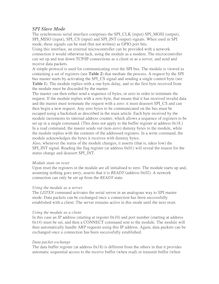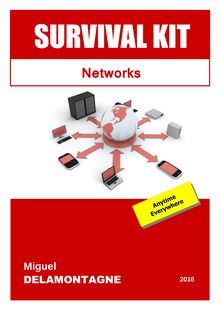#ip-address

Documents
SPI Slave Mode The synchronous serial interface comprises the SPI CLK input SPI MOSI output SPI MISO input SPI CS input and SPI INT output signals When used in SPI mode these signals can be read but not written as GPIO port bits Using this interface an external microcontroller can be provided with a network connection it would otherwise lack using the module as a modem The microcontroller can set up and tear down TCP IP connections as a client or as a server and send and receive data packets A simple protocol is used for communicating over the SPI bus The module is viewed as containing a set of registers see Table that mediate the process A request by the SPI bus master starts by activating the SPI CS signal and sending a single control byte see Table The module replies with a one byte delay and so the first byte received from the module must be discarded by the master The master can then either send a sequence of bytes or zero in order to terminate the request If the module replies with a zero byte that means that it has received invalid data and the master must terminate the request with a zero: it must deassert SPI CS and can then begin a new request Any zero bytes to be communicated on the bus must be escaped using a backslash as described in the main article Each byte received by the module increments its internal address counter which allows a sequence of registers to be set up in a single command This does not apply to the buffer register at address 0x18 In a read command the master sends out non zero dummy bytes to the module while the module replies with the contents of the addressed registers In a write command the module acknowledges the bytes it receives with dummy bytes Also whenever the status of the module changes it asserts that is takes low the SPI INT signal Reading the flag register at address 0x01 will reveal the reason for the status change and deassert SPI INT Module state on reset Upon reset the registers in the module are all initialised to zero The module starts up and assuming ...
Jensn

Documents
Rapports de stage
SPI Slave Mode The synchronous serial interface comprises the SPI CLK input SPI MOSI output SPI MISO input SPI CS input and SPI INT output signals When used in SPI mode these signals can be read but not written as GPIO port bits Using this interface an external microcontroller can be provided with a network connection it would otherwise lack using the module as a modem The microcontroller can set up and tear down TCP IP connections as a client or as a server and send and receive data packets A simple protocol is used for communicating over the SPI bus The module is viewed as containing a set of registers see Table that mediate the process A request by the SPI bus master starts by activating the SPI CS signal and sending a single control byte see Table The module replies with a one byte delay and so the first byte received from the module must be discarded by the master The master can then either send a sequence of bytes or zero in order to terminate the request If the module replies with a zero byte that means that it has received invalid data and the master must terminate the request with a zero: it must deassert SPI CS and can then begin a new request Any zero bytes to be communicated on the bus must be escaped using a backslash as described in the main article Each byte received by the module increments its internal address counter which allows a sequence of registers to be set up in a single command This does not apply to the buffer register at address 0x18 In a read command the master sends out non zero dummy bytes to the module while the module replies with the contents of the addressed registers In a write command the module acknowledges the bytes it receives with dummy bytes Also whenever the status of the module changes it asserts that is takes low the SPI INT signal Reading the flag register at address 0x01 will reveal the reason for the status change and deassert SPI INT Module state on reset Upon reset the registers in the module are all initialised to zero The module starts up and assuming ...
Jensn
3 pages
English
Collection
{{collectionTitle}}
Collection
{{collectionTitle}}
Collection
{{collectionTitle}}
{{productCategoryLabel}}
{{productTitle}}
{{productAuthors}}
{{productCategoryLabel}}
{{productThemeLabel}}
{{productTitle}}
{{productAuthors}}
{{productPages}}
{{productLanguageIsoCode}}
